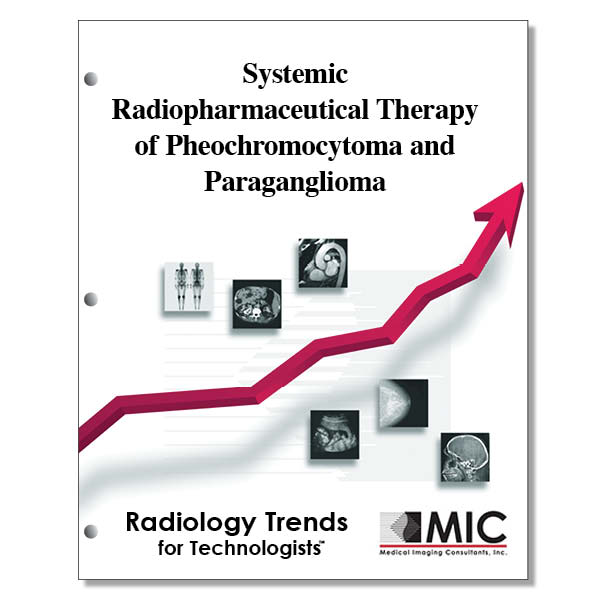

Systemic Radiopharmaceutical Therapy of Pheochromocytoma and Paraganglioma
Clinical features of pheochromocytoma and paraganglioma are presented, including symptoms, management options, imaging findings, and the role of genetic and hormonal biomarkers. Additionally, radiopharmaceutical agents for treatment of metastatic or inoperable disease are explored.
Course ID: Q00715 Category: Radiology Trends for Technologists Modalities: Nuclear Medicine, Radiation Therapy2.00 |
Satisfaction Guarantee |
$24.00
- Targeted CE
- Outline
- Objectives
Targeted CE per ARRT’s Discipline, Category, and Subcategory classification:
Nuclear Medicine Technology: 2.00
Procedures: 2.00
Endocrine and Oncology Procedures: 2.00
Outline
- Introduction
- General Considerations for Systemic RPT in Pheochromocytoma and Paraganglioma
- Patient Preparation Before RPT
- Post-RPT Radiation Protection
- 131I-MIBG Therapy
- 131I-MIBG production
- Patient Selection and Preparation for 131I-MIBG RPT
- 131I-MIBG Administration
- Clinical Experience with 131I-MIBG in Pheochromocytoma and Paraganglioma
- Dosimetric Scans
- Side Effects and Toxicity Profile
- Summary
- PRRT with Radiolabeled Somatostatin Analogs
- Patient Selection and Preparation
- PRRT Administration
- Clinical Experience with PRRT in Pheochromocytoma and Paraganglioma
- Dosimetry
- Response Evaluation with PRRT
- Side Effects and Toxicity Profile
- Summary
- Conclusion
Objectives
Upon completion of this course, students will:
- identify characteristics associated with pheochromocytoma
- understand what tumors of sympathetic origin secrete
- identify which radiopharmaceutical comes in HSA or LSA options
- list variables that contribute to the survival rate of pheochromocytoma and paraganglioma
- identify the FDA approved radiopharmaceutical for pheochromocytoma and paraganglioma
- list medications used for catecholamine blockade prior to treatment
- understand the NRC regulations that allows treatment on an outpatient basis
- list the characteristics associated with 131I-MIBG
- describe preparations with high mass MIBG that can cause pharmacologic effects
- identify the patient screening tests needed prior to 131I-MIBG treatment
- identify the recommended HSA 131I-MIBG dose based on patient weight
- understand the dosimetry infusion rates with HSA 131I-MIBG
- understand the dose ranges for LSA 131I-MIBG
- understand LSA 131I-MIBG doses and organ toxicity
- list the criteria for an outpatient treatment of LSA 131I-MIBG
- identify variables associated with LSA 131I-MIBG infusion
- describe the LSA 131I-MIBG treatment schedule for metastatic pheochromocytoma bone lesions
- understand the biochemical response associated with HSA 131I-MIBG therapy
- list functional imaging options following RPT to evaluate treatment response
- describe when whole body dosimetry imaging is performed following 131I-MIBG
- identify the most common adverse side effect following HSA 131I-MIBG therapy
- understand how gastrointestinal toxicity is handled following LSA or HSA 131I-MIBG therapy
- understand the steps required for patient eligibility and 131I-MIBG
- list the current somatostatin imaging agents available
- explain the dose limiting organs affected by PRRT
- describe when amino acid pre treatment is administered prior to 177Lu-DOTATATE
- identify the FDA approved radiopharmaceutical for NET therapy
- list imaging modalities used for disease regression following PRRT
- understand renal absorbed dose toxicity limits with PRRT
- describe the current accepted dose protocol for PRRT
- describe changes that are frequently used to evaluate treatment response to PRRT
- describe the higher risks patients with pheochromocytoma or paraganglioma may incur following PRRT
- identify hematologic side effects following PRRT
- identify the radiopharmaceutical for pheochromocytoma and paraganglioma recommended by the National Comprehensive Cancer Network
- identify other considerations necessary prior to PRRT or 131I-MIBG therapy
